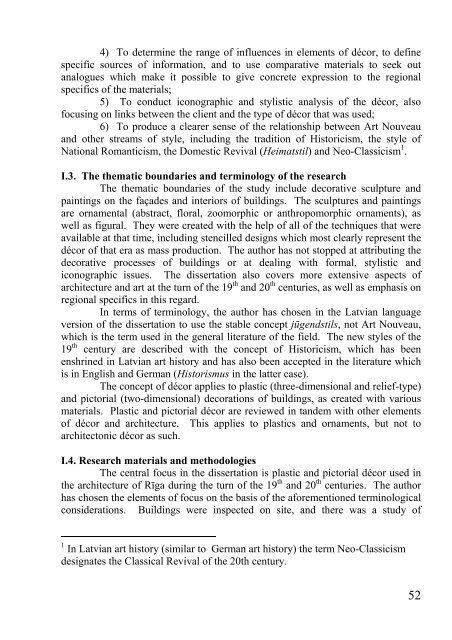SILVIJA GROSA JŪGENDSTILA PERIODA PLASTISKAIS UN ...
SILVIJA GROSA JŪGENDSTILA PERIODA PLASTISKAIS UN ...
SILVIJA GROSA JŪGENDSTILA PERIODA PLASTISKAIS UN ...
Create successful ePaper yourself
Turn your PDF publications into a flip-book with our unique Google optimized e-Paper software.
4) To determine the range of influences in elements of décor, to define<br />
specific sources of information, and to use comparative materials to seek out<br />
analogues which make it possible to give concrete expression to the regional<br />
specifics of the materials;<br />
5) To conduct iconographic and stylistic analysis of the décor, also<br />
focusing on links between the client and the type of décor that was used;<br />
6) To produce a clearer sense of the relationship between Art Nouveau<br />
and other streams of style, including the tradition of Historicism, the style of<br />
National Romanticism, the Domestic Revival (Heimatstil) and Neo-Classicism 1 .<br />
I.3. The thematic boundaries and terminology of the research<br />
The thematic boundaries of the study include decorative sculpture and<br />
paintings on the façades and interiors of buildings. The sculptures and paintings<br />
are ornamental (abstract, floral, zoomorphic or anthropomorphic ornaments), as<br />
well as figural. They were created with the help of all of the techniques that were<br />
available at that time, including stencilled designs which most clearly represent the<br />
décor of that era as mass production. The author has not stopped at attributing the<br />
decorative processes of buildings or at dealing with formal, stylistic and<br />
iconographic issues. The dissertation also covers more extensive aspects of<br />
architecture and art at the turn of the 19 th and 20 th centuries, as well as emphasis on<br />
regional specifics in this regard.<br />
In terms of terminology, the author has chosen in the Latvian language<br />
version of the dissertation to use the stable concept jūgendstils, not Art Nouveau,<br />
which is the term used in the general literature of the field. The new styles of the<br />
19 th century are described with the concept of Historicism, which has been<br />
enshrined in Latvian art history and has also been accepted in the literature which<br />
is in English and German (Historismus in the latter case).<br />
The concept of décor applies to plastic (three-dimensional and relief-type)<br />
and pictorial (two-dimensional) decorations of buildings, as created with various<br />
materials. Plastic and pictorial décor are reviewed in tandem with other elements<br />
of décor and architecture. This applies to plastics and ornaments, but not to<br />
architectonic décor as such.<br />
I.4. Research materials and methodologies<br />
The central focus in the dissertation is plastic and pictorial décor used in<br />
the architecture of Rīga during the turn of the 19 th and 20 th centuries. The author<br />
has chosen the elements of focus on the basis of the aforementioned terminological<br />
considerations. Buildings were inspected on site, and there was a study of<br />
1 In Latvian art history (similar to German art history) the term Neo-Classicism<br />
designates the Classical Revival of the 20th century.<br />
52












